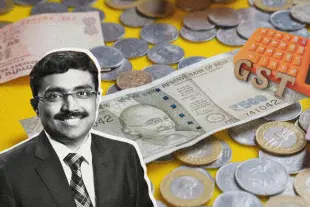Economy
GST Reforms: Rate Rationalisation Complete, What Ajay Rotti Says Comes Next
Diksha Yadav
Sep 09, 2025, 12:55 PM | Updated Oct 09, 2025, 09:06 AM IST
Save & read from anywhere!
Bookmark stories for easy access on any device or the Swarajya app.


The recent GST Council meeting delivered sweeping changes. In a candid conversation on Swarajya's "What This Means" podcast, tax expert, founder and CEO of Tax Compaas, Ajay Rotti provided insights into why these reforms were inevitable, their broader implications, and what still needs to be done. Here's a comprehensive breakdown of the key takeaways from this discussion.
The Original GST Structure: A Transitional Necessity, Not A Permanent Feature
A crucial point often overlooked in GST discussions: the original four-slab structure (5%, 12%, 18%, 28%) was always meant to be temporary. "The four rates that we had was genuinely because of our political compromise, without which I don't think we could have commenced GST implementation in the first place," Rotti explained.
States were reluctant participants initially, giving up their constitutional right to tax goods and their existing revenue streams. The complex rate structure was the price of consensus – without it, GST might never have launched. "The two-slabs should have been the original structure, and we couldn't have got there on day one because of the states," Rotti said.
The expert revealed that even during the original implementation, policymakers knew this was unsustainable long-term. "When it was started itself, we knew that that cannot be a long term thing and we had to move to a more simple structure." The recent changes represent what he called "a natural course correction" — moving from a "politically negotiated framework to more of what is driven today by economics and rationale."
The GST Council Meeting: Wider Changes Than Expected
Rotti expressed surprise at the scope of the reforms, calling them "much wider and sweeping than what I had expected personally." The council effectively eliminated two of the four original slabs, with most goods moving to either 5% (merit rate for essentials) or 18% (standard rate), while luxury and sin goods moved to a consolidated 40% rate.
The unanimity and speed of decision-making, he suggested, weren't really about one-day efficiency. "The whole conclusion is not a one day thing... the rate rationalisation committee had already suggested some of these things." Behind-the-scenes consensus-building had been occurring for months, with states apparently fearing much larger revenue losses than the final numbers suggested.
The success of the meeting, according to Rotti, demonstrates how India's federal structure can work effectively. "The GST council, in my view, has been a great success for how the federal structure is supposed to work."
Clearing Up Classification Confusion
Addressing the much-publicised "salted and caramel popcorn coming under the same or different tax slab confusion", Rotti was direct: "I don't think there was a genuine confusion, all types of popcorn, along with most food items, are under the 5% slab. I don't think there was any confusion. I think it was just some confusion created by some quarters."
With the new simplified structure, he expects such classification disputes to diminish significantly, as most food items now clearly fall under the 5% category.
On differential rates for single product categories like footwear (5% up to ₹2,500, then 18%), he said that they are economically logical. "You cannot today have a footwear which is costing 15k, 20k 30k rupees to be subject to 5% and a 300 rupee footwear which is worn every day by somebody at the same rate.
"Now whether it (rate change) has to be at 2500 or 5000 or 10000 rupees can always be debated. But that's best left to the policymakers. Similarly for cars, you cannot have a 1 crore rupee car being subject to the same percentage of tax as a 5 lakh rupee car, for example.
But, we cannot have that kind of regressive indirect tax at this point. We still need many goods taxed at 5%. Therefore, which really means we also need some taxed at 40% to collect the revenues that we do," Rotti explained.
Health Sector Focus: Beyond Economic Rationale
The reforms showed particular attention to healthcare, with health insurance moving from 18% to complete exemption, alongside reductions for pharmaceuticals, medical devices, and health-related services.
Rotti characterised the health insurance's complete exemption as a "welfare measure" rather than a purely economic decision.
"Our insurance cover is not like what it will be in other countries. We don't have social security covers. People have to buy their health insurance. Our public health is not what it is in some of the Western countries," he explained.
The government chose to forgo revenue here rather than collect taxes and redistribute through welfare programs.
"I think it was not so much about economic rationale in bringing down the health insurance rates. But I think some of these are political compulsions. Some of these, given where we are, are welfare measures, more than anything else.
"You would rather do something like this and not collect revenue here than collect the revenue and use it again in some form to give back as welfare. You would rather reduce the taxes on something like health insurance."
However, he warned that the full 18% benefit might not reach consumers due to technical issues with input tax credits under exempted categories. When a service becomes exempt rather than zero-rated, providers lose the ability to claim credits on their inputs, which become costs. "The reduction in price may not be entirely 18% but it will be substantial... the reduction could be 15%, 16%, 14%, we will have to wait and see," he estimated.
The Revenue Impact: Not Really a "Loss"
Rotti strongly disagreed with characterizing the estimated ₹48,000 crore impact as a "revenue loss," supporting the revenue secretary's framing of it as a "fiscal impact." His reasoning was multi-layered:
First, the calculation assumes consumption patterns identical to 2023-24, which won't hold. "The consumption in this year need not mirror what it was in 23-24."
Second, basic economics suggests lower prices should boost consumption. "There's more money in the hands of the people. If they save 18% on something, they could go and spend it on something else."
Third, the complexity makes accurate prediction impossible. He used a business analogy: "If you are running a business and you pricing a pen at 15 rupees and you are selling X number of items... if it goes to 12 rupees with a higher sale you may end up with a higher absolute profit."
The Anti-Profiteering Challenge
On whether benefits would reach consumers, Rotti pointed to Section 171 of the GST law, which mandates that businesses pass on rate reductions. "The law is extremely clear," he stated, explaining that companies cannot profit from tax cuts - they must adjust prices proportionally.
However, with the National Anti-Profiteering Authority disbanded and no dedicated enforcement mechanism currently in place, compliance depends largely on business good faith and government nudging rather than regulatory enforcement.
Future Reform Priorities: Beyond Rate Rationalisation
With rates settled, Rotti suggested the next reform agenda on GST should focus on administrative, litigation and compliance improvements:
Centralised Systems: Moving toward centralised registration and standardised state procedures to eliminate the current "dual structure" problems where "state officers are asking the same questions" as central authorities.
Sector-Specific Guidance: Developing standardised approaches across states for different industries - "give guidance across to states on sector-wise to say all states can focus on these issues for banks, for example, for telecom companies, for software companies."
Litigation Reduction: Addressing the continuing problem of "multiple notices that get issued across different states asking the same thing."
Process Simplification: The announced three-day registration process and operationalisation of GST appellate tribunals are steps in this direction, but much more remains to be done.
The Compliance Challenge Ahead
Rotti emphasised that rate rationalisation, while important, addresses only part of the GST experience. "If your compliances are difficult, if administration is difficult, if dealing with the tax office is difficult, then that creates a problem."
The success of GST's next phase will depend largely on making these administrative interactions smoother. As he concluded, "With the bigger issue of rates being sorted out, at least in the near future, there's a lot of work to do on the other aspects to really get GST to the desired state that we all want it to be."
Looking Forward: A Reformed Foundation
The recent GST changes represent more than tax adjustments - they mark the evolution from a politically negotiated compromise to an economically rational system. While challenges remain in administration and compliance, the foundation is now set for India's indirect tax system to mature into the efficient, growth-supporting mechanism it was always intended to become.
Note: We explore this in greater detail in the podcast. You can listen to the full episode here.
Diksha Yadav is a senior sub editor at Swarajya.





